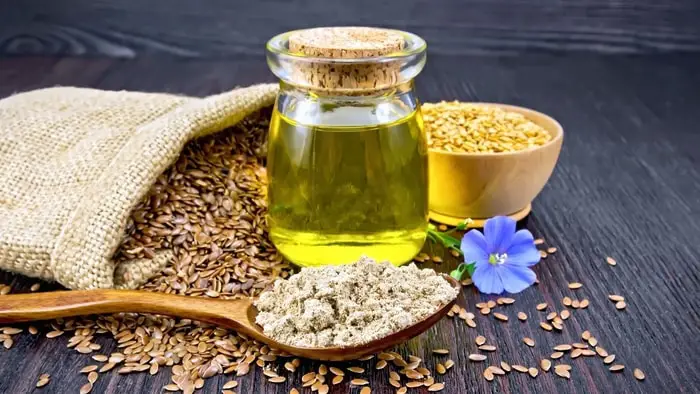Last Updated on July 12, 2021
Before we start talking about substitutions for wheat bran, let’s take a look at what wheat bran is, and if it’s gluten-free. As celiac or intolerant individuals, we are accustomed to seeing the word wheat and running for the hills. In this case, rightly so! Wheat bran is the hard outer, fibrous layer of the wheat kernel itself.
The main difference between wheat bran and wheat itself, is that wheat is the collective name. Wheat bran is a component of wheat. The other components of wheat are endosperm and germ. You can find out more about the different components here.
Wheat bran is hard to digest and can cause issues like abdominal pain and diarrhea – so maybe it is lucky we can’t have it, as I’m sure most of us have had enough of that in our lives already! It isn’t gluten-free, so let’s take a look at what other options are available.
Wheat Bran Substitute In Baking
Bran is great for fiber intake and helps you to feel fuller for longer. Luckily, wheat bran isn’t the only option available. There’s a wide range of healthy, delicious substitutes.
- Almond flour
- Amaranth seed
- Amaranth flour
- Buckwheat flour
- Flax Seed
- Flax Seed Meal
- Chickpea flour
- Garfava flour
- Mesquite flour
- Montina flour
- Quinoa grain
- Quinoa flour
- Gluten-free Oat Bran
- Gluten-Free Oat flour
- Rice bran
- Teff grain
- Teff flour
Many of these are difficult to source, so let’s take a look at some of the most accessible alternatives, and how to incorporate them into everyday life.
Rice Bran
Rice bran can be found in most supermarkets and health stores. It’s naturally gluten-free and doesn’t taste very different to wheat bran. The taste is very mild, and it’s versatile. This particular substitute contains a whopping 39g of dietary fiber in every cup full. This particular type of bran is used a lot in Asian cooking. Again, it’s a component of the grain itself – and is a very healthy alternative. You can read more about the benefits here.
Rice bran can be used for a range of meals but is probably best suited for breakfast. It’s very dense and will keep you going for hours. When looking at rice bran, and its uses, muffin recipes will be the predominant offering. I found these gluten-free rice bran muffins, which would make a perfect start to the day.
Flaxseed
Flaxseed and Flaxseed Meal are essentially the same thing – meal is just partially ground up. Again, it’s easily accessible in your local supermarket and health shops. Its taste is earthy but has an underlying sweetness. Most importantly, it has a staggering 45.9g of dietary fiber in every cup! In other words, you’ll definitely be meeting your daily quota there. However, remember not to eat too much – it can lead to gut issues.
There are many uses for flaxseed, however, we’re going to be taking a look at flaxseed bread. The recipe can be found here. Also, this recipe is suitable for vegans. With only seven ingredients, it’s a great way to incorporate bran into your diet in a quick and easy way.

Read more about: Gluten Free Bread Brands At Walmart
Chickpea Flour
Next, we’re going to be looking at chickpea flour. Although a great substitute for wheat bran, it’s not quite as fibrous as our other options. It contains 20.9g of fiber in each cup. They have a very strong nutty flavor, so maybe is best to avoid if that’s not your thing. Chickpeas are also high in protein, which is great for vegans/vegetarians.
Everyone deserves a treat every so often, so I’ve found these yummy flourless chocolate chickpea blondies. Gluten-free, vegan, and healthy – what more could you ask for?!
Gluten-Free Oat Flour
Perhaps the easiest substitute of them all to obtain is gluten-free oat flour. It has a very subtle taste and behaves very much like wheat flour. It only has 12g of dietary fiber in a cup, but I think the ease with which it can be obtained, and its sheer versatility makes it one of the more favorable choices. If like me, you have a separate oat allergy, you may want to steer clear of this one.
If looking for something to make that’s a bit more extravagant, why not try this Easy Vanilla Vegan Gluten Free Cake. Gluten-free celebration cakes can be hard to source, especially at the last minute, so this recipe could be a great solution.
Quinoa Flour
The last of the substitutions for wheat bran we’re going to be looking at today is quinoa flour. Again, it’s relatively easy to source but ranks lowest on the fiber scale with only 6.6g of dietary fiber per cup. Although low, it can be incorporated into most meals. One of them being an all-time favorite – pancakes.
Gluten-free pancakes that don’t crumble and still taste delicious are almost impossible to find. However – that’s where quinoa flour comes in! The taste is quite earthy and nutty, but boy does it make some fluffy pancakes!
Pancakes are definitely one of the most diverse meals out there. Perfect for breakfast, lunch, dinner, or dessert – depending on what you accompany it with, of course.
Check out this vegan quinoa flour pancakes recipe here.
What’s Your Favorite Substitute For Wheat Bran?
It’s easy to incorporate wheat bran substitutes into your diet, and I hope this article has helped you navigate this part of your gluten-free diet better. And encourages you to find options best suited to you. This lifestyle can be a challenging one to follow at first, but I promise you, it does get easier. And it definitely isn’t as restricting as it first seems!
What substitutes do you think you’ll be opting for? Maybe you’ve already incorporated them into your gluten-free lifestyle? Or maybe you have some alternatives of your own that you think are just as good as the options listed above? If so, please let us know.
Now, I’m off to make quinoa pancakes for dinner!
Read more about: How To Make Nacho Cheese Without Flour

Hi, my name’s Zoë. I’m 28 years old and live in London, UK. I work full time as a freelance writer and critic for West End theatre. Writing has been a passion of mine for as long as I can remember. I spend most of my free time at the theatre, or at conventions. I’m married to the love of my life, and live in a small apartment with my fur baby, Lillie. I run two of my own blogs: No Safer Place and Stage to Page: both of which have won awards. I also have a YouTube channel where I talk about all things stagey.
